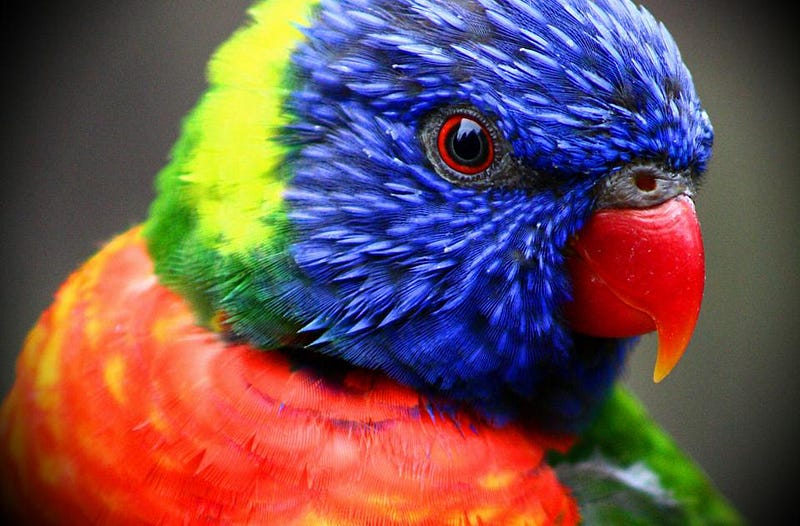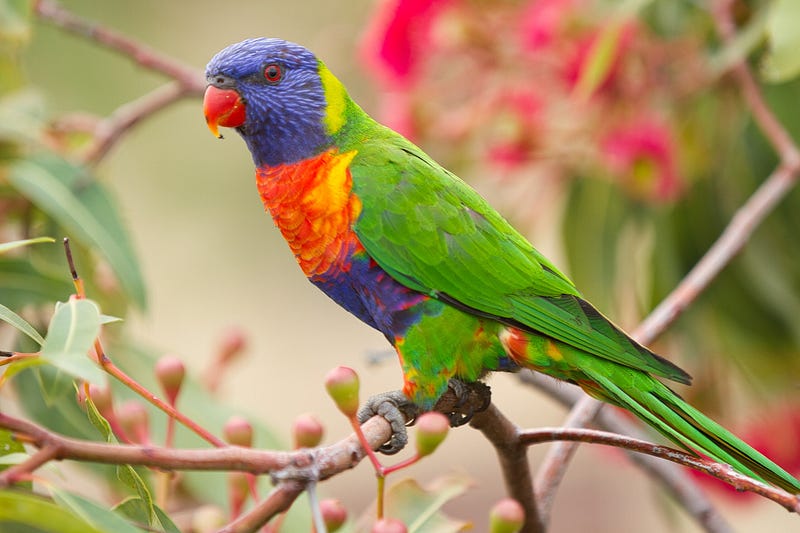Title: Balancing Colorful Attractiveness and Predator Avoidance in Parrots
Written on
Chapter 1: The Dazzling World of Lories and Lorikeets
The rainbow lorikeet (Trichoglossus moluccanus), a nectar-loving parrot species, thrives along Australia’s eastern coastline, inhabiting rainforests, coastal scrub, and woodlands.

Lories and lorikeets, which encompass over 100 species, are small to medium-sized parrots native to regions including New Guinea and eastern Indonesia. These birds exhibit a spectacular range of colors—from vivid lime greens and sunny yellows to fiery oranges and deep scarlets, alongside shades of blue and shimmering blacks—some even beyond human perception. This prompts an intriguing question: how do these parrots flaunt such vibrant hues without falling prey to predators?
Previous studies have indicated that feather coloration serves multiple functions, such as regulating temperature and adapting to climates. However, a team of evolutionary biologists at the American Museum of Natural History sought to delve deeper into the balance between sexual attraction and camouflage. Their research focused on museum specimens of lories and lorikeets, known for their exceptional ability to remain hidden from predators while also dazzling potential mates.
In contrast to many bird species where males boast bright colors and ornate feathers while females blend in, lories display a striking characteristic: both genders are equally colorful and often indistinguishable by color alone. Remarkably, these parrots tend to follow a consistent pattern in their coloration, displaying vivid heads and chests with green backs and upper wings. This raises the possibility of “mosaic evolution” at play.
Mosaic evolution describes the phenomenon where traits evolve at varying rates or in distinct manners. This concept emerged from early discoveries of Archaeopteryx fossils, which exhibited a mix of primitive and advanced features. Essentially, traits that are interrelated are expected to evolve together, while those that are less connected can develop independently.

Given the significance of color in mate selection among lories, researchers hypothesized that plumage areas associated with sexual signaling would evolve more freely compared to those on the back and wings, where camouflage could be compromised. They also considered that environmental influences could drive variations in color across different regions of the birds.
To test these ideas, the team analyzed 98 historical museum specimens, capturing images under both visible and UV light. “The spectrum of colors seen in lorikeets encompasses about a third of what birds can theoretically perceive,” stated lead author Jon Merwin. “We were able to document variations that are invisible to the human eye.”
Data from 35 color patches across various body parts—including the head, wings, and abdomen—were collected and analyzed through a specialized computer program that simulates avian vision. This color data was then applied to the evolutionary tree of lories to determine whether specific plumage patches were more inclined to evolve under certain conditions.
The results confirmed that plumage colors do not develop uniformly in lories. Analysis of the 35 regions revealed that changes occurred significantly faster for color patches concentrated on the head and belly compared to those on the wings and back. Additionally, wing coloration appeared more influenced by climatic factors than signaling colors, which diversified rapidly.
These findings bolster the theory that the remarkable color diversity among lories arises from a mosaic of evolutionary processes acting on different plumage areas. Mosaic evolution thus offers a framework for understanding how these birds can showcase vibrant signaling colors while maintaining their ability to blend in with their environment.
Source:
Jon T. Merwin, Glenn F. Seeholzer & Brian Tilston Smith (2020). Macroevolutionary bursts and constraints generate a rainbow in a clade of tropical birds, BMC Evolutionary Biology 20:32 | doi:10.1186/s12862–020–1577-y
Originally published at Forbes.com on 31 December 2022. Keep up with my writing with my free newsletter.
Chapter 2: Understanding the Mechanisms of Color Evolution
No youtube to insert. Don't generate youtube directive.